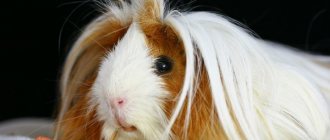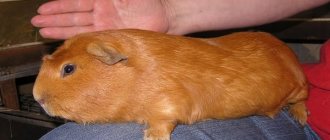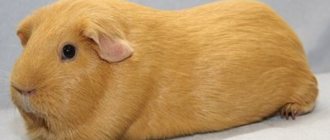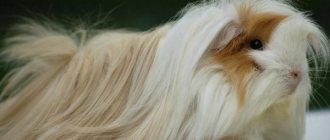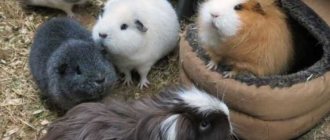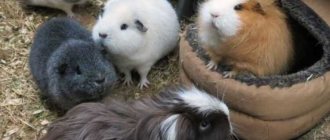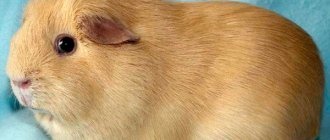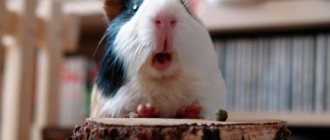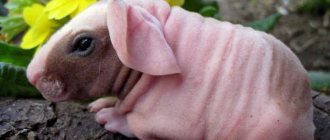A little history
Scientists suggest that wild guinea pigs themselves came to human habitation in search of warmth. The Indians who lived in pre-Columbian America kept these animals as livestock and consumed them as food and also sacrificed them to the gods.
Guinea pigs appeared in Europe only in the 16th century. Long-haired guinea pigs first appeared in France. There are now long-haired guinea pig nurseries all over the world. And animal lovers began their selective breeding.
Shorthair breeds
The second name for this large group of rodents is smooth-haired. Representatives of this population can most often be found among ordinary people; animals are no less popular in scientific circles, where they are used as experimental animals.
All breeds in this category are characterized by the presence of smooth, even coat; the hairs fit tightly to the body. According to the type of color, they are divided into plain and variegated.
- Ordinary. In appearance it resembles a ball, it is so compact and stocky. The eyes are round, large, and black. The ears are set wide apart, hang down, and have no hair. The color can be any, mainly spots of black, white, and red are scattered throughout the body. There are also single-colored individuals.
- Self. Characterized by uniform coloring of the entire fur coat. At the same time, there can be a great variety of color variations: albino, black, gold, red, cream, saffron, purple. Eye color - black or red. The hair grows back, the “hairstyle” is always neat, like a real English queen.
- Satin, in other words - satin. The charm and beauty of these pigs lies in the incredible shine of their hair, which is especially pronounced in the spotlight or in the sun. In principle, this type can be classified in the previous group of monochromatic ones, because the difference lies only in the structure of the hair - in “satin” it is hollow inside, which is why it shimmers in bright light.
- Russians. Sometimes pigs are also called Himalayan, although they have nothing to do with the Himalayas and were bred in our country. The peculiarity of the “piglets” is their snow-white body with black (chocolate) paws, ears and muzzle. This coloring appears well in cool climates, but if the ambient temperature is too high, the pigment will lighten and the animal will be completely white.
- Motley. Not one breed, but includes several.
- Dutch. It is distinguished by its unusual color, characterized by the presence of dark spots on the cheeks and the back half of the body. In this case, the white spot on the muzzle should have the shape of a regular wedge. The Dutch weigh slightly less than their relatives, have a soft, easy-going character and get along well with children.
- Agouti. The most common species are golden and silver. There are also chocolate, cream and brown. Each hair is divided into three color zones, while the abdomen is monochromatic. The breed is considered one of the hardiest and most prolific. By the way, there is an opinion that agouti are the progenitors of all currently available breeds of pigs.
- Speckled. Alternating black and red stripes throughout the fur coat. The latter look like spots with a clear separation boundary. Sometimes there are variations of the three-stripe color, when white is also added.
- Tortoiseshell. The presence of clear spots of black, red and white colors, alternating in a special order. At the same time, the fur coat looks like a patchwork quilt or even a chessboard. By the way, in Russia these rodents are often called “cakes”, which is similar to the English name of the breed - torty&white.
Description of long-haired pigs
One of our favorite pets is the long-haired guinea pig. Descriptions of different breeds may differ, but there are common characteristics. All pigs have a small oval-shaped body. The head has a “Roman” profile, large ears and large bulging eyes. The legs are short, the tail is practically absent.
The nose is large, with a slight hump. The structure of teeth is special. The lower and upper incisors are large and have no roots. They grow throughout their lives. Naturally sharpened. There are small distances between the incisors and molars.
Long-haired guinea pigs differ from simple guinea pigs precisely in the length of their coat, which can reach 20, and in Peruvian - even 50 cm. Moreover, the hair grows not only on the body, but also on the head. Breeds of long-haired guinea pigs differ in the structure of their coat and its color. The color range is very diverse.
It can be either monochromatic or variegated, combining three colors. The most common color has red shades. But sometimes there are guinea pigs with fur that is pure white or completely black.
Preparation for exhibitions
Not only immediately before exhibitions, but almost every day, a guinea pig must be bathed, since its fur cannot help but get dirty. Regular human shampoo will also work, which then needs to be washed out along with a separate hair conditioner. After bathing and drying, the wool is sprinkled with dry talcum powder, which makes it even silkier. Long hair can (and should) be wrapped in curlers, however, they will fall off if the length of the hair does not reach 4.5 cm.
moy-pitomec.ru
Breeds of long-haired guinea pigs
Long-haired breeds of guinea pigs are conventionally divided into two main groups: with straight or curly hair. But all of them are unpretentious to the conditions of detention. There are many breeds. The most popular are described below:
- Sheltie. This breed of pig has smooth and soft fur. Grows from the muzzle to the body. Any rosettes or swirls are unacceptable. The hair on the face is short, with whiskers. The color can be plain or variegated.
- Coronet. The breed was bred in England. The pigs got their name from the woolen crown-shaped rosette on their head. The muzzle is framed by sideburns. The hair on the body is straight and silky, without rosettes or cowlicks. It grows starting from the muzzle. The color can be plain or variegated. The Coronet differs from the Sheltie breed only in the rosette on its head.
- Texel. These guinea pigs have curly, elastic hair. Grows from the muzzle to the sacrum. Colors can be very diverse.
- Merino. This breed got its name due to its long, curly coat and rosette on its head. This is what distinguishes them from texels.
- Alpaca. The breed is identical to the Peruvian. Pigs have thick bangs on their heads. The fur grows towards the muzzle. There are two rosettes on the sacrum. Alpacas differ from Peruvian pigs in having curly hair.
- Swiss Teddy. The breed is very valuable and rare. Externally, pigs look like a ball of wool. It is quite thick, hard to the touch, erect and slightly curly. Its length is approximately six centimeters, the same throughout the pig’s body. The fur on the tummy is curly. According to the standard, cowlicks and rosettes are not allowed, except for one on the head. Color – plain or variegated.
- Lunkaria. This breed is also considered exotic. It differs from other breeds in its coarse and curly locks.
Reproduction and breeding of the breed
As you know, this breed was bred by crossing an American and a Peruvian, and therefore the Sheltie’s body contains genes for both long-hair and short-hair. Therefore, if you cross a guinea pig of this breed with any other, you will get a hybrid animal with rosettes of hair on the body. However, when two Shelties are crossed, the result is only a Sheltie.
When crossing American and Peruvian guinea pigs, statistically every sixteenth “pig” will be a Sheltie. If you isolate him and cross him with another representative of the same breed, you can breed your own Sheltie “at home.”
Character
The long-haired guinea pig is a very friendly pet. These exotic rodents are sociable and active. When they get used to the house and owners, they are very willing to make contact. They love attention to their person. They get along well with rabbits. But other animals and birds (dogs, cats, parrots, etc.) can be dangerous for them.
Long-haired guinea pigs are quite peaceful and bite very rarely. But small children cannot be left alone with them, as children can injure the small animal. And the animal, when frightened, bites. They can be cared for by children as young as six or eight years old.
Guinea pigs are highly trainable. They quickly remember their name and respond to it with ease. They can recognize even simple commands or certain sounds. They are tamed quickly, provided that they are given enough attention. You need to talk to guinea pigs. They love to be petted and picked up.
Sheltie
Sheltie guinea pigs are very similar to Peruvian guinea pigs in that they have long, smooth coats. However, there is a difference between them. The Sheltie's coat on the head looks like it's combed back. It is on this basis that the breed is difficult to confuse with any other.
The Sheltie's long, beautiful coat requires proper care, so you'll want to take that into account if you're considering getting one. The breed has many colors and is perfect for small children, but not for grooming, but just for playing. As with other long-haired breeds, the parents must take on most of the grooming.
Nutrition
The long-haired guinea pig eats in the same way as its ordinary counterparts. The diet should include grass, hay and grains. The herb is slightly dried before serving. Be sure to give your pigs carrots, cucumbers, beets with tops, apples and greens. But all of the above should be included in the diet in small portions.
Potatoes can only be given boiled, and very little. It is better to soak the grains a little and feed them in the morning. Sprouted grains are beneficial. Feeding should be twice a day. Uneaten food is removed from the cage after two hours. The water should be filtered and fresh.
Long-haired guinea pigs: care and maintenance
To keep guinea pigs, you need a spacious cage (minimum 60x40x60) so that the animal can move freely. It is installed away from drafts and the sun, to which animals are very sensitive. The house is located low in the cage, since pigs cannot fall even from a small height.
A tray is desirable as it makes cleaning easier. The cage should have a drinking bowl and two food bowls, as well as a small manger for grass and hay. In the cage you need to secure a piece of chalk and a strong branch (for grinding down teeth). Sawdust or shavings are suitable for bedding. Cleaning is done daily. The litter is changed every other day. Guinea pigs should be allowed out for daily walks.
The coat is brushed daily with a soft brush. At least 3-4 times a week. Washing guinea pigs is not recommended at all. But if this is necessary, then only after severe contamination. The wool is dried with a towel or hair dryer. If it is very long, then it is put away in paper curlers. The ears are inspected regularly and, if necessary, cleaned with cotton swabs. Claws are trimmed once a month.
Lifespan
On average, pig-like rodents live about 5 years. With good care, the pet enjoys a life of 6 to 8 years. Sometimes especially lucky pigs live up to 10 years.
The short life expectancy is compensated by incredible fertility. 15 hours after giving birth, the female is ready to mate again as she goes into estrus. The offspring usually consists of 9 or 10 individuals. Thus, one individual can bring up to 100 babies per year.
Frequent births are not good for the animal, so it is better not to allow the female to give birth more than 2 times a year.
Diseases
The long-haired guinea pig gets sick very rarely and is immune even to infectious diseases. But there are a number of diseases that animals can be susceptible to:
- obesity;
- scurvy;
- rickets;
- cold;
- epilepsy;
- keratitis;
- heart disease;
- allergies;
- pneumonia;
- conjunctivitis;
- tumors;
- otitis media;
- paralysis;
- skin infections;
- ringworm;
- salmonellosis and some other diseases.
